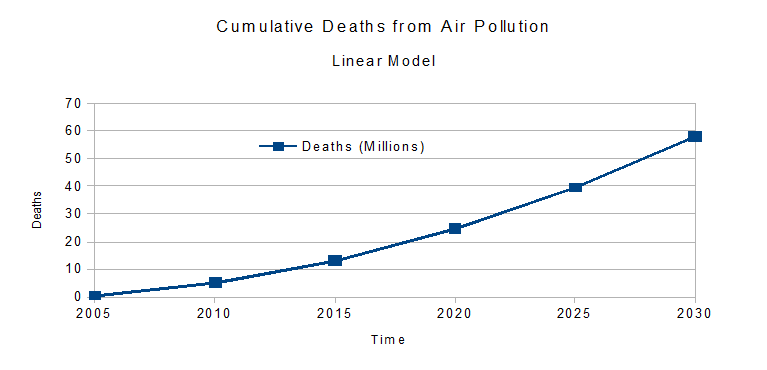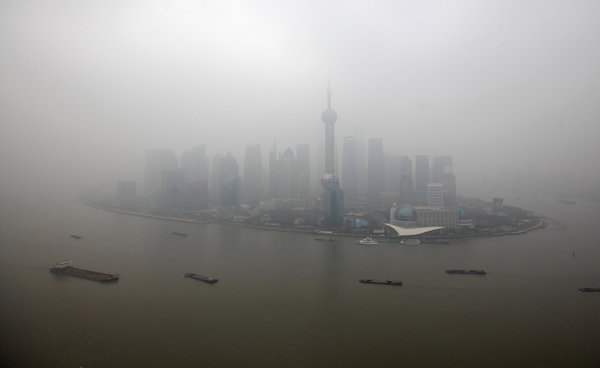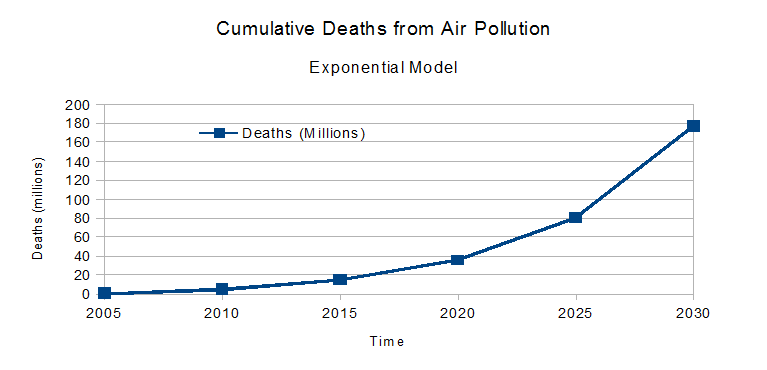
Airpocalypse Beijing.
副作用可以杀死 Fùzuòyòng kěyǐ shā sǐ Side Effects Can Kill
China, since 1947, has become an economic powerhouse. But back in 2007, National Geographic reported, here, on a World Health Organization, WHO, report, that 656,000 people died in China in 2006 from air pollution. National Geographic also reported that polluted drinking water killed at the rate of 95,000 people per year in China in 2006. In 2012, The Guardian reported, here, that in 2010, 1.2 million people died in China and North Korea from air pollution.
Side Effects can kill. 副作用可以杀死 Fùzuòyòng kěyǐ shā sǐ
Based on those reports, in 2013, I extrapolated (here and here) that unless the Chinese authorities did something – like replace coal with solar, wind, and clean base line generation – then 1.9 to 2.6 million people would die in China in 2015 and a total of 12.7 million to 14.2 million will have died in China due to air pollution between 2005 and 2015.

This analysis is within the margin of error of the study by Berkeley Earth, here, as reported in the NY Times, here.

Airpocalypse
My models suggest that if unchecked the death rate from air pollution could increase to a total of 24.7 to 35.2 million by 2020 and a total of 58 to 177.7 million by 2030.
The reason for the seemingly wide discrepancy is that I used two (2) models: a linear growth model and an exponential growth model.
Table 1, below, shows a simple linear extrapolation of deaths in China increasing at the steady rate of $137,500 per year. Table 1 also shows the cumulative total estimated deaths due to air pollution as a percentage of the estimated current total population of China.
| Air Pollution Deaths in China | |||
| Simple Linear Extrapolation – Annual Increase of 137,500 | |||
| Year | Deaths | Cumulative | % of population |
| people | 1,300,000,000 | ||
| 2005 | 512,500 | 512,500 | |
| 2010 | 1,200,000 | 5,137,500 | 0.40% |
| 2015 | 1,887,500 | 13,200,000 | 1.02% |
| 2020 | 2,575,000 | 24,700,000 | 1.90% |
| 2025 | 3,262,500 | 39,637,500 | 3.05% |
| 2030 | 3,950,000 | 58,012,500 | 4.46% |
| Table 1 | |||
This was the rate of increase based on the data reported for 2006 and 2010. However, it seems to me that natural systems such as “deaths due to air pollution” operate according on exponential curves, not linear curves. Thus, the worse the air gets, the more people will be effected, and the longer it will take the system to return to a clean steady state.

Table 2, below, shows the annual and cumulative deaths if the death rate increases by 16.57% annually, the cumulative totals and the cumulative totals as a percentage of the current estimated population of China.
| Air Pollution Deaths in China | |||
| Simple Exponential Extrapolation – Annual increase of 16.57% | |||
| Year | Deaths | Cumulative | % of population |
| people | 1,300,000,000 | ||
| 2005 | 542,328 | 542,328 | |
| 2010 | 1,200,000 | 5,062,674 | 0.39% |
| 2015 | 2,582,420 | 14,790,428 | 1.14% |
| 2020 | 5,557,349 | 35,724,485 | 2.75% |
| 2025 | 11,959,377 | 80,774,429 | 6.21% |
| 2030 | 25,736,494 | 177,721,588 | 13.67% |
| Table 2 | |||
My analysis predicted that 1.750 Million to 2.215 million would die from air pollution in China in 2014. According to Berkeley Earth, 4,400 people died each day in April, 2014. That would equate to 1.6 million in 2014, if the death rate was constant, however, it is, of course, increasing. Robert Rohde and Richard Muller, the authors of the Berkeley Earth paper, also say that 1.6 million is the midpoint of the range, that actual results, they say, are likely to be between 700,000 and 2.2 million. Complicating their analysis and my analysis is the Chinese government’s propensity to censor data.
The difference between the “Bitter Years of Widespread Famine” of 1959 – 1961 (ISE Modern Word History, here, Wikipedia, here) and the “Bitter Years of Widespread Air Pollution” of 2006 – today to the foreseeable future is back in the late 1950’s China faced a food distribution problem. This was, essentially, a logistics problem. Rather than accept help from the United States, the Chinese government chose to let people starve. Today there is what might be termed an “Air pollution distribution problem.” But it is a whole lot easier to distribute food, even if it means accepting help from mistrusted and hated foreigners, than to un-distribute air pollution. Especially when the air pollution is caused by systems that are integral to your economy. It’s not as if the Chinese can simply turn off all the factories and coal plants permanently as they did temporarily for the 2008 Olympic Games (NY Times, here).
The 12.7 million to 14.2 million people who I estimated died in China from air pollution between 2005 and 2015 is roughly 1.1% of the current population. The 15 million to 43 million who died between 1958 and 1962 was roughly 2.3% to 6.5% of the population at the time (661 million). But while the population is bigger today, and the death rate smaller, the expectations, including life expectancy, of the average person in China are also greater than during those Bitter Years, the First Bitter Years.
So what happens next?
Bellona Europa noted here,
Premier Li Keqiang, who represented China at the summit, announced that the country will cut its CO2 emissions per unit of gross domestic product by 60-65% from 2005 levels. Moreover, China would increase its share of non-fossil fuels as part of its primary energy consumption to about 20% by 2030. 2030 is also the year by which China will aim to peak its emissions of CO2 emissions.
However, the Chinese won’t do this until 2030, by which time, if my analysis is correct, 58 million to 177.7 million people will have died from air pollution. It looks like the Chinese authorities think,
First we complete our plans to industrialize. After all, we can’t have industrialization without pollution.
首先,我们完成我们的计划实现工业化。毕竟,我们不能有产业没有污染。
Shǒuxiān, wǒmen wánchéng wǒmen de jìhuà shíxiàn gōngyèhuà. Wǒmen bùnéng yǒu chǎnyè méiyǒu wūrǎn.
This is, literally, the party line. Rainbow Builders, here, writes,
Before the large scale industrialization which started with Mao Zedong in 1949, the life expectancy was 36 years; now, it is about 73 years. Compare this with the 2-4 months of life lost because of air pollution, and you will understand why the Chinese chose industrialization.
Rainbow Builders also maintains that no more than 400,000 people die each year from air pollution in China. The World Health Organization, WHO, reported, here, in 2012,
- 1,476873 deaths, “27% of the 5,469,900 deaths … were from “indoor air pollution.”
- 34,700 child deaths, “44% percent of an estimated 34,700 child deaths due to acute lower respiratory infections is attributable to household air pollution.”
It looks to me like deaths from air pollution in China are going to increase, even after 3030. Side effects can kill.
–
Note that the data described in the Guardian includes North Korea. Therefore my analysis lumps North Korea with China. While this introduces error into my analysis, North Korea’s relatively small population, estimated at 24 million, less than 1.85% of the population of China, and it’s relative lack of industrialization suggest that deaths from air pollution in N. Korea will not dramatically alter the results and may be caused by air pollution from China.
Links:
- National Geographic, Chinese Air Pollution Deadliest in World, Report Says,
- The Guardian, Pollution from car emissions killing millions in China and India,
- NY Times, Study Links Polluted Air in China to 1.6 Million Deaths a Year,
- Berkeley Earth, Air Pollution in China: Mapping of Concentrations and Sources,
- Popular Logistics, China Air Pollution: The Bitter Years Return?
- Popular Logistics, Forget the Great Wall – Meet the Great Haze
- Google Translate
–
An analyst with Popular Logistics, I hold an MBA in “Managing for Sustainability” from Marlboro College, and a BS in biology. I am not an epidemiologist or a statistician. I also have over 20 years experience in Information Technology. Available as a speaker and consultant, I can be reached at “L Furman” at “Popular Logistics . com”.